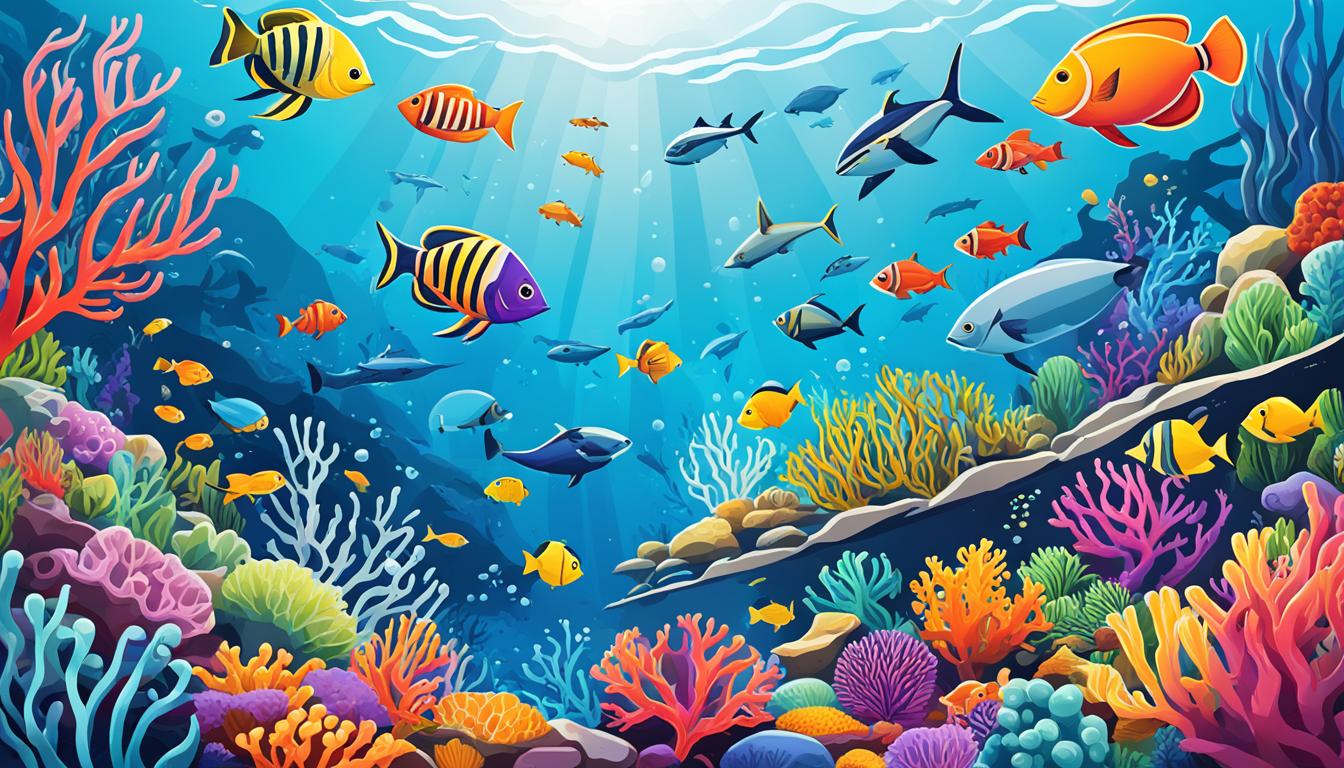Imagine diving into the depths of the ocean and embarking on an adventure through a vast and mysterious world. As you descend, you become surrounded by the rhythmic swaying of colorful coral reefs, the graceful dance of marine creatures, and the awe-inspiring expanse of aquatic habitats.
The ocean, covering approximately 70% of Earth’s surface, is not only essential for our survival, but it also holds an incredible diversity of life. This vast blue expanse teems with marine biodiversity, offering a home to millions of species that are waiting to be discovered, understood, and protected.
Did you know that only about a quarter of the ocean floor has been mapped, covering an area three times the size of the moon? It’s a vast, unexplored frontier that holds countless secrets and surprises for us to uncover.
So far, just over 240,000 marine species have been identified, but scientists estimate that there could be as many as 2.2 million species in total. That means we have barely scratched the surface, with only about 10% of marine life described. Every year, an average of 2,300 new marine species are discovered, adding to our knowledge of this remarkable ecosystem. And with initiatives like the Ocean Census aiming to discover 100,000 species over the next decade, there is still so much more to learn and explore.
The wonders of oceanic ecosystems extend far beyond their sheer biodiversity. Ocean exploration provides us with invaluable data on biological, chemical, physical, geological, and archaeological aspects of the ocean. It helps us understand weather patterns, climate changes, earthquakes, and even tsunamis. The insights gained from ocean exploration drive technological innovations and engineering advancements that have applications far beyond the realm of the ocean itself.
But the importance of exploring the ocean goes beyond scientific discovery. It plays a vital role in national security, with the exploration of the U.S. Exclusive Economic Zone being crucial. Ocean ecosystems also hold tremendous potential for medical therapies, vaccines, food, and energy sources. Furthermore, exploring the ocean can inspire the next generation of scientists, technologists, engineers, and mathematicians, boosting ocean literacy and paving the way for a brighter future.
It is essential that we recognize the significance of the ocean and take action to protect it. By 2030, experts predict catastrophic consequences due to climate change and plastic pollution if we fail to reduce carbon emissions. These consequences could include ecosystem collapse, rising sea levels, and intensified extreme weather events. We must strive to make sustainable choices and prioritize ocean conservation to preserve the wonders of oceanic ecosystems and ensure a healthy future for generations to come.
Let’s dive into the fascinating world beneath the waves, unravel its mysteries, and champion the preservation of our oceanic treasures.
Key Takeaways:
- The ocean covers approximately 70% of Earth’s surface and is teeming with marine biodiversity.
- Only a quarter of the ocean floor has been mapped, leaving vast areas unexplored.
- Just over 240,000 marine species have been identified, with an estimated 2.2 million species yet to be described.
- Ocean exploration provides data on various aspects of the ocean and aids in understanding weather patterns, climate changes, and natural disasters.
- Exploring the ocean drives technological innovations, inspires careers, and boosts ocean literacy.
The Majes-teeth of Whale Sharks and Narwhals
Under the vast expanse of the ocean, two fascinating marine animals stand out for their unique dental features: the majestic whale shark and the mythical narwhal. Let’s dive into the world of these incredible creatures and uncover the secrets behind their extraordinary teeth.
Whale Sharks: Guardians of the Deep
Whale sharks, the largest fish in the world, are gentle giants that roam the ocean depths. Despite their enormous size, reaching up to 18 meters in length and 20 tons in weight, their diet consists mainly of tiny plankton. And while they don’t possess traditional teeth, they have a fascinating adaptation known as eye denticles. These tiny teeth-like structures located on their eyeballs serve as a protective mechanism, safeguarding their eyes from abrasion and damage as they navigate through the water.
Narwhals: The Unicorns of the Sea
In the Arctic waters, narwhals captivate our imagination with their long, spiraling tusks. These tusks are not actually horns but elongated canine teeth protruding from their head. The narwhal’s tusk, often reaching an impressive length of 9 feet (2.7 meters) or more, grows straight, unlike conventional tusks. This uniqueness makes them the only straight tusks in the world.
The purpose of the narwhal’s tusk has been the subject of much scientific intrigue. While the exact function is still debated, researchers believe that it plays a crucial role in sensory perception. With about ten million tiny holes on its surface, the tusk acts as a vital sensory organ, allowing the whale to detect changes in water pressure, temperature, and salinity. It serves as a remarkable example of adaptation in marine animals.
Unlocking the Secrets of Marine Teeth
The teeth of whale sharks and narwhals are just two examples of the incredible diversity of teeth found in marine animals. From the filter-feeding giants to the deep-sea hunters, every species has its unique dental adaptations that serve a variety of purposes. These adaptations provide insights into the extraordinary ways marine animals have evolved to survive and thrive in their aquatic habitats.
To further appreciate the diversity of teeth in marine animals, we can explore the elasmobranch group, which includes an array of sharks, rays, and skates. These fascinating creatures practice internal fertilization, with offspring developing through either oviparity (laying eggs) or viviparity (live birth). Their unique eggs, often referred to as mermaid’s purses due to their distinctive appearance, have distinct shapes that aid in increasing the survival chances of the offspring by preventing predators.
| Whale Sharks | Narwhals |
|---|---|
| Whale sharks can reach up to 18 meters in length and 20 tons in weight. | Narwhals possess curly, elongated tusks that can grow up to 9 feet (2.7 meters) or more. |
| They are filter feeders, consuming plankton, krill, small fish, and occasionally small squid or crustaceans. | Their tusks serve as a sensory organ, detecting changes in water pressure, temperature, and salinity. |
| Migration patterns across international waters are crucial for their survival. | Male narwhals typically grow a tusk, while female narwhals have tusks at a much lower rate. |
These fascinating adaptations continue to captivate researchers and ignite our curiosity about the wonders of the ocean. The teeth of marine animals shed light on their remarkable abilities to thrive in different environments and evolve alongside their changing habitats.
Mermaid’s Purse Collection
Elasmobranchs, which include sharks, rays, and skates, use various reproductive strategies to ensure the survival of their offspring. While some give live birth, others lay eggs. These unique shark eggs, often referred to as mermaid’s purses, showcase remarkable adaptations that contribute to the survival of the developing embryos.
Mermaid’s purses come in a variety of shapes and sizes, each tailored to suit different environments and provide protection. Some shark species have eggcases with distinctive designs, such as corkscrew shapes or bright colors, which aid in their attachment and camouflage underwater. These adaptations increase the chances of eggs surviving in their specific habitats.
For example, horn sharks have corkscrew-shaped eggcases that allow them to be wedged into crevices, keeping them safe from predators and strong currents. Draughtboard shark eggs are equipped with tendrils that anchor them onto kelp, preventing them from drifting away and becoming vulnerable to predation. These adaptations highlight the intricate relationship between sharks and their environment.
These egg adaptations are not limited to sharks alone. Skates, a type of ray, also produce distinct eggcases. Skates have lateral keels on their eggcases that help them anchor to the seafloor, providing stability and protection for the developing embryos.
The diversity of mermaid’s purses reflects the evolution and survival strategies of elasmobranchs. By studying and tracking these eggcases, researchers and conservationists can gain insights into important areas for reproduction and take measures to protect shark, skate, and chimaera populations.

Lake Under the Sea and Reef Above the Land
Exploring the depths of the ocean reveals fascinating natural wonders that often remain hidden from our view. Two such marvels are brine pools and coral reefs, which exist in contrasting environments but share their significance in supporting diverse ecosystems.
Brine pools, also known as underwater lakes, can be found in the ocean’s denser basins, where highly saline water accumulates. These pools create extreme conditions, with high levels of salinity and high pressure, making them inhospitable for most marine life. However, despite the harsh environment, certain microbial species have adapted to thrive in these unique habitats. These remarkable brine pools, resembling ethereal underwater lakes, are a testament to the resilience and adaptability of nature.

On the other hand, coral reefs are vibrant ecosystems that exist above the water’s surface due to millions of years of tectonic movements. Composed of calcium carbonate secreted by marine organisms, coral reefs are stunning examples of karst landscapes. These underwater masterpieces support an exceptional array of marine life, including fish, turtles, and countless other organisms. Found in marine ecosystems such as estuaries and coastal zones, coral reefs are home to up to a quarter of all ocean species. Their beauty and ecological importance make them invaluable treasures that need our protection and conservation efforts.
Brine pools and coral reefs are distinct yet interconnected wonders of the ocean. While brine pools showcase the resilience of life in extreme environments, coral reefs mesmerize us with their vibrant colors and intricate ecosystems. Together, they remind us of the awe-inspiring diversity and complexity present in our underwater world.
The Importance of Ocean Conservation
The next decade is crucial for ocean conservation. Experts predict catastrophic consequences by 2030 if we don’t address the pressing issues of climate change and plastic pollution. The impacts go far beyond the ocean itself, affecting every living being on Earth.
The ocean is a vital component of our planet, absorbing 25 per cent of all carbon emissions, which helps mitigate climate change. Additionally, it generates 50 per cent of the oxygen necessary for human survival. The wellbeing of the ocean is intrinsically linked to our own wellbeing.
“The ocean is as important to humanity as our lungs are to breathing.” – Ocean Care
However, the alarming reality is that over 60 per cent of major marine ecosystems are being utilized unsustainably. This unsustainable exploitation puts marine life at risk and jeopardizes the health of the entire ecosystem.
Marine resources also hold significant economic value, estimated at US $3 trillion per year. The ocean tourism industry alone grows by approximately US $134 billion annually. But activities like coral bleaching, which causes an annual loss of up to $12 billion in tourism revenue, threaten this economic potential.
Furthermore, with projections indicating that by 2050, one billion people will be living in low-lying coastal areas, the urgency to protect and conserve the ocean becomes even more evident. Factors such as climate change, overfishing, acidification, and pollution are compromising the health and resilience of marine ecosystems, exacerbating the risks faced by coastal communities.
The need for sustainable choices cannot be overstated. Every year, more than 10 million tons of fish are wasted due to destructive fishing practices. Unless we make significant changes, over 50 per cent of the world’s marine species may face extinction by 2100, according to UNESCO.
We must act decisively and collectively to preserve the ocean’s wonders and ensure its vitality for future generations. This requires adopting sustainable practices, reducing carbon emissions, and finding innovative solutions to combat plastic pollution. Together, we can make a difference and safeguard this invaluable resource that covers three-quarters of the Earth’s surface and feeds about half of the world’s population.

Join the global efforts in ocean conservation and be part of the solution for a sustainable and thriving future.
Advancements in Ocean Exploration
Ocean exploration is continuously advancing, fueled by the development of cutting-edge underwater technology. These advancements enable researchers to delve into uncharted territories and uncover the secrets of the deep seas. From discovering historical shipwrecks to exploring hydrothermal vents, oceanic explorers are pushing the boundaries of knowledge and innovation.
One of the remarkable aspects of underwater technology is its ability to uncover shipwrecks with historical and archaeological significance. These shipwrecks serve as a window into the past, providing valuable insights into our maritime history. For instance, the discovery of the ship on which renowned explorer Ernest Shackleton perished sheds light on the heroic adventures of early pioneers.
Autonomous vehicles and sensors are revolutionizing ocean exploration by reducing carbon emissions and expanding the scope of research. These vehicles can navigate treacherous underwater environments, collecting valuable data and imagery without risking human lives. They allow us to explore remote areas, such as hydrothermal vents, which are rich in geological and biological discoveries.

Exploring the Depths with Autonomous Vehicles
Autonomous vehicles have become indispensable tools for ocean exploration. Equipped with state-of-the-art technology, these vehicles can operate independently, capturing high-definition images and videos, and collecting data in real-time. They play a vital role in advancing our understanding of the ocean’s vast ecosystems and geological formations.
“Autonomous vehicles are revolutionizing the field of ocean exploration, enabling us to reach depths never before possible and uncover the mysteries of our planet’s last frontier.”
Their ability to navigate treacherous underwater landscapes with precision and accuracy has significantly contributed to the discovery of new species and the mapping of unexplored regions. These vehicles, like the Remote Operated Vehicle (ROV) Seirios, have been illuminating the pathway for other ROVs, such as the ROV Deep Discoverer, since 2011, and continue to pave the way for future explorations.
Technological Innovations Enhancing Data Collection
Technological advancements in underwater cameras and imaging systems have greatly expanded our ability to capture remarkable footage and imagery from the depths of the ocean. The Deep Discoverer, for example, has been upgraded with a high-definition camera system, an extreme low-light camera, a dimmable LED lighting system, and a BlueView scanning sonar system. These enhancements enable researchers to extend the reach and applications of video and photo data, uncovering hidden wonders of the deep.
“Technological innovations have transformed how we explore the ocean, allowing us to capture breathtaking images and document previously unseen phenomena.”
Furthermore, the use of video alone has led to significant scientific discoveries. The National Oceanic and Atmospheric Administration (NOAA) recently designated a new genus and species of organism, a comb jelly, near Puerto Rico solely through video evidence collected during a NOAA Ocean Exploration expedition. This demonstrates the power of technology in expanding our understanding of the marine environment.
As ocean exploration progresses, researchers continue to overcome challenges, fostering technological and engineering innovations along the way. Curiosity, knowledge, and the spirit of adventure drive modern ocean explorers, propelling us towards a deeper understanding of the Earth’s environment and its response to natural hazards.
Collaboration between public, private, and academic sectors, such as the partnership between NOAA Ocean Exploration and various institutions, further enhances our understanding of the marine environment. By sharing resources, expertise, and data, we can collectively unravel the mysteries of the ocean and work towards sustainable management of its resources for future generations.
Breathtaking Discoveries in the Ocean
The ocean is a world full of wonders and mysteries waiting to be uncovered. From the depths of the sea to the surface, incredible discoveries have captured the attention and imagination of researchers and explorers alike. Let’s delve into some of the most breathtaking discoveries in the ocean.
The Colossal Squid: Unveiling a Deep-Sea Giant
 One of the most captivating discoveries in the deep ocean is the colossal squid. This elusive creature, one of the largest animals in the deep ocean, has fascinated scientists with its immense size and mysterious nature. With its enormous eyes and tentacles reaching up to 10 meters in length, the colossal squid remains a truly remarkable deep-sea inhabitant.
One of the most captivating discoveries in the deep ocean is the colossal squid. This elusive creature, one of the largest animals in the deep ocean, has fascinated scientists with its immense size and mysterious nature. With its enormous eyes and tentacles reaching up to 10 meters in length, the colossal squid remains a truly remarkable deep-sea inhabitant.
The Impact of Solar Flares: Unforeseen Consequences in the Ocean
While solar flares are commonly associated with phenomena occurring in space, their impact can also reach the depths of the ocean. These powerful bursts of energy can disrupt the Earth’s magnetic field, affecting compasses and equipment used by scientists to monitor the ocean. The interplay between the sun and the ocean highlights the complex forces that shape our planet.
Mysterious Holes on the Ocean Floor: Unearthing Uncharted Secrets
Off the coast of Big Sur, scientists have discovered mysterious holes on the ocean floor. These enigmatic features, found at great depths, have left researchers intrigued and eager to uncover their origins and significance. With each exploration, we come closer to unraveling the mysteries hidden beneath the surface of the sea. Using advanced technology like remotely operated vehicles and sonar mapping, scientists are meticulously studying these unusual formations. By collecting samples and analyzing data, they hope to shed light on what causes these peculiar holes, whether they are natural or human-made. As researchers delve deeper, they are not only exploring hidden insights and mysteries of the ocean floor but also uncovering how little we still know about Earth’s vast and uncharted waters.
New Species in Unexplored Regions: Deep-Sea Marvels
The ocean holds a treasure trove of undiscovered species, and scientists continue to identify new deep-sea inhabitants in previously unexplored regions. From the depths of the South China Sea to the remote corners of the Pacific Ocean, new species of crabs, fish, and other deep-sea creatures have been added to our ever-growing knowledge of marine life.
| Discovery | Description |
|---|---|
| Colossal Squid | One of the largest deep-sea animals, captivating researchers |
| Solar Flare Impact | Affects the ocean’s magnetic field and compasses used for monitoring |
| Mysterious Holes | Discovered off the coast of Big Sur, intriguing scientists |
| New Deep-Sea Species | Crabs, fish, and other creatures found in unexplored regions |
The ocean continues to surprise and amaze us with its breathtaking discoveries. Whether it’s the colossal squid, the impact of solar flares, mysterious holes on the ocean floor, or the identification of new species in unexplored regions, these findings remind us of the vast wonders that await us beneath the waves.
The Ongoing Exploration of the Ocean
Scientists are continuously exploring the vast and mysterious depths of the ocean, leading to remarkable discoveries that expand our understanding of the marine world. These ongoing explorations have unveiled fascinating phenomena, unique species adaptations, and new avenues for technological advancements.
Deep-Sea Sinkholes: Unveiling Uncharted Depths
During recent expeditions, researchers have uncovered the planet’s deepest under-ocean sinkhole, a monumental discovery that offers unparalleled opportunities for exploration. These sinkholes, located in the darkest and most remote regions of the deep sea, present challenging landscapes yet to be fully explored by scientists.
Bioluminescent Shrimp: Illuminating the Abyss
Deep-sea exploration has revealed that bioluminescence is far more prevalent among shrimp species than previously thought. Scientists have identified 157 deep-sea shrimp species capable of emitting light, expanding our knowledge of the fascinating adaptations developed by marine organisms living in extreme environments.
New Animal Discoveries: Expanding Our Knowledge of Marine Life
Exploration efforts have led to the discovery of numerous new animal species thriving in the mysterious depths of the ocean. For example, a unique crab was recently found 3,000 feet under the sea, showcasing the astounding biodiversity that exists beneath the surface. These new discoveries contribute to our understanding of marine ecosystems and the interconnectedness of marine life.
Deep-Sea Photography: Capturing the Sublime
Advancements in deep-sea photography have allowed researchers to capture stunning images of the hidden wonders of the ocean. These mesmerizing photographs offer glimpses into the breathtaking beauty and diversity of marine life, inspiring awe and fostering a deeper appreciation for our planet’s underwater realms.
Ocean Exploration Game: Inspiring the Next Generation
As technology continues to advance, innovative tools and platforms are emerging to engage and educate individuals about the wonders of the ocean. One such example is the ocean exploration game, FathomVerse. This game, designed to spark curiosity and inspire a love for ocean exploration, provides players with a virtual platform to learn about marine ecosystems, conservation efforts, and the importance of protecting our oceans.

| Deep-Sea Sinkholes | Bioluminescent Shrimp | New Animal Discoveries | Deep-Sea Photography | Ocean Exploration Game |
|---|---|---|---|---|
| Scientists have found the planet’s deepest under-ocean sinkhole, reaching depths yet to be explored. | 157 deep-sea shrimp species have been discovered with the ability to emit light through bioluminescence. | New animal species, including a unique crab, have been found in unexplored regions of the deep sea. | Advancements in deep-sea photography have enabled the capture of stunning images of the ocean’s hidden beauty. | The ocean exploration game, FathomVerse, aims to inspire curiosity and raise awareness about oceanic wonders. |
The ongoing exploration of the ocean holds tremendous potential for uncovering even more discoveries and deepening our knowledge of the marine environment. As scientists continue to delve into the mysteries of the ocean, we gain valuable insights that can inform conservation efforts, inspire technological innovation, and foster a deeper connection to this vast and diverse ecosystem.
Conclusion
The ocean is a vast and awe-inspiring wonder that covers about 70% of the Earth’s surface. It is home to a diverse array of marine species, comprising approximately half of the world’s biodiversity. From the smallest algae to the majestic coral reefs, the ocean holds countless wonders waiting to be discovered and explored.
It is crucial that we prioritize sustainable practices to protect and preserve the future of the ocean. Marine organisms have evolved unique defense mechanisms and have provided us with valuable resources, including FDA-approved drugs and compounds with potential medical applications.
By safeguarding marine ecosystems and reducing our carbon footprint, we can ensure the ocean’s vital role in regulating the Earth’s climate and supplying water to the planet. Additionally, sustainable practices in fisheries, aquaculture, tourism, and shipping can generate significant economic opportunities while preserving the ocean’s beauty and resources for future generations.
Let us embrace the wonders of the ocean and work collectively to support sustainable practices that will secure a bright future for this magnificent ecosystem.
FAQ
What are oceanic ecosystems?
Why is marine biodiversity important?
What are aquatic habitats?
How does ocean conservation benefit marine life?
What are underwater ecosystems?
How does ocean ecology impact the planet?
Why is marine conservation important?
What are marine ecosystems?
What are oceanic environments?
Source Links
- https://www.sevencleanseas.com/post/the-peculiar-wonders-of-the-marine-world
- https://oceanexplorer.noaa.gov/facts/why.html
- https://animals.howstuffworks.com/mammals/narwhal.htm
- https://www.saveourblueocean.shop/post/the-hidden-gems-of-the-ocean-floor-discovering-unique-marine-species
- https://saveourseas.com/mermaids-purses/
- https://www.salon.com/2023/10/12/treasure-trove-of-skate-egg-mermaid-purses-found-in-deep-sea/
- https://www.abyss.com.au/en/blog/viewpost/483/sydney-diving-uncover-mermaids-purses-sharks
- https://www.nationalgeographic.org/encyclopedia/marine-ecosystems/
- https://www.un.org/en/desa/5-reasons-you-should-care-about-our-ocean
- https://oceanliteracy.unesco.org/ocean-conservation/
- https://oceanexplorer.noaa.gov/20years/technology.html
- https://oceanexplorer.noaa.gov/news/oceanexplorationnews/welcome.html
- https://www.livescience.com/planet-earth/rivers-oceans/10-mind-boggling-deep-sea-discoveries-in-2023
- https://education.nationalgeographic.org/resource/ocean-exploration
- https://www.sciencedirect.com/topics/agricultural-and-biological-sciences/marine-ecosystem
- https://www.geeksforgeeks.org/threats-to-marine-ecosystems/










